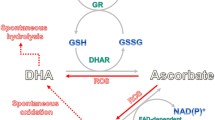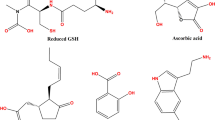Abstract
Binding interactions of cadmium (Cd) with rice ascorbate peroxidase (OsAPX) in presence or absence of jasmonate was examined in-silico. OsAPX is a 250 amino acid long protein with 90 % sequence similarity to soybean-APX. The 3D model of OsAPX obtained by homology modeling using soybean APX (PDBID:1OAF) as template was associated with −15975.85 kJ/mol energy, 100 % residues in favoured region, verify score of 0.85, ERRAT score 89.625 and a negative ProSA graph, suggesting OsAPX model to be of good quality, robust and reliable which was submitted with Protein Model Database with PMDBID: PM0078091. The rice ascorbate peroxidase ascorbate [OsAPX–Asc] complex had a substrate binding cavity involving residues at position 30KSCAPL35, 167RCH169 and 172R wherein ascorbate accommodated via three H-bonds involving 30Lys at the γ-edge of heme. 169His served as a bridge between heme-porphyrin of OsAPX and ascorbate creating a charge relay system. Cd bound in [OsAPX–Asc–Cd] complex at 29EKSCAPL35, a site similar to ascorbate binding site. The binding of Cd caused breaking of 169His bridge shifting the protein conformation. Cadmium exhibited four electrostatic interactions via 29Glu of OsAPX backbone. Docking of [OsAPX–Asc] with jasmonic acid (JA) resulted in [OsAPX–Asc–JA] complex where 4—H-bonds held JA to OsAPX in a cavity at γ-edge on the distal side of heme. The binding of [OsAPX–Asc–JA] to Cd show the metal to bind at a position other than that involved in binding of OsAPX with Cd alone. Results indicate that Cd does not replace iron or ascorbate or JA but binds to OsAPX on the surface at a separate site electrostatically. In presence of JA the interactions involved in formation of [OsAPXAsc] are restored which is otherwise altered by the presence of Cd. The formation and reformation of H-bond take place between the [OsAPX–Asc] and Cd/JA. It is the interaction between heme and ascorbate which is modulated differently in presence of Cd/JA. In absence of JA, Cd-binds to the [OsAPX–Asc] complex at the proximal end of APX near Asc-binding site, whereas in presence of JA, Cd-binds on the opposite site of the Asc-binding site involving 30Lys and 29Glu residues. In-silico binding studies well correlate with the wet-lab results where exogenous application of JA increased the activity of OsAPX in rice grown under Cd-stress. Therefore it is concluded that the activity of OsAPX in rice roots and shoots are compromised under Cd-stress alone.










Similar content being viewed by others
References
Altschul SF, Gish W, Miller W, Myers EW, Lipman DJ (1990) Basic local alignment search tool. J Mol Biol 215:403–410
Attwood TK, Bairoch A, Bateman A, Birney E, Biswas M, Bucher P, Cerutti L et al (2001) The InterPro database, an integrated documentation resource for protein families, domains and functional sites. Nuc Acids Res 29:37–40
Belkhadi A, Hediji H et al (2011) Effects of exogenous salicylic acid pre-treatment on cadmium toxicity and leaf lipid content in Linum usitatissimum L. Ecotoxicol Environ Saf 73:1004–1011
Bernstein FC, Koetzle TF, Williams GJB, Meyer EF Jr, Brice MD, Rogers JR, Kennard O, Shimanouchi T, Tasumi M (1977) The Protein Data Bank: a computer-based archival file for macromolecular structures. J Mol Biol 112:535-542
Bonagura CA, Sundaramoorthy M, Pappa HS, Patterson WR, Poulos TL (1996) An engineered cation site in cytochrome c peroxidase alters the reactivity of the redox active tryptophan. Biochem 35:6107–6115
Bursey EH, Poulos TL (2000) Two substrate binding sites in ascorbate peroxidase: the role of arginine 172. Biochem 27:7374–7737
Celik A, Cullis PM, Sutcliffe MJ, Sangar R, Raven EL (2001) Engineering the active site of ascorbate peroxidase. Europ J Biochem 268:78–85
Colovos C, Yeates T (1993) Verification of protein structures: patterns of nonbonded atomic interactions. Protein Sci 2:1511–1519
DeLano WL (2002) The PyMOL Molecular Graphics System. http://www.pymol.org
Ding CK, Wang CY, Gross KC, Smith DL (2001) Reduction of chilling injury and transcript accumulation of heat shock proteins in tomato fruit by methyl jasmonate and methyl salicylate. Plant Sci 161:1153–1159
Escuredo PR, IturbeOrmaetxe I, Arrese-Igor C, Becana M (1998) Oxidative damage in pea plants exposed to water deficit or paraquat. Plant Physiol 116:173–181
Gumiero A, Murphy EJ, Metcalfe CL, Moody PCE, Raven EL (2010) An analysis of substrate binding interactions in the heme peroxidase enzymes: a structural perspective. Arch Biochem Biophys 500:13–20
Hegedüs A, Erdei S, Horváth G (2001) Comparative studies of H2O2 detoxifying enzymes in green and greening barley seedlings under cadmium stress. Plant Sci 160:1085–1093
Hill AP, Modi S, Sutcliffe MJ, Turner DD, Gilfoyle DJ, Smith AT, Tam BM, Lloyd E (1997) Chemical, spectroscopic and structural investigation of the substrate binding site in ascorbate peroxidase. Eur J Biochem 248:347–354
Hoagland DR, Arnon DI (1938) The water-culture method for growing plants without soil. Agri Experim Station Circ 347. Berkeley, CA, USA 3:346–347
Jespersen HM, Kjaersgard IVH, Østergadd L, Welinder KG (1997) From sequence analysis of three novel ascorbate peroxidases from Arabidopsis thaliana to structure, function and evolution of seven types of ascorbate peroxidase. Biochem J 326:305–310
Junyu HE, Yanfang R, Xuebo P, Yuping Y, Cheng Z, Dean J (2010) Salicylic acid alleviates the toxicity effect of cadmium on germination, seedling growth, and amylase activity of rice. J Plant Nutr Soil Sci 173:300–305
Keramat B, Kalantari KM, Arvin MJ (2009) Effects of methyl jasmonate in regulating cadmium induced oxidative stress in soybean plant (Glycine max L.). Afric J Microbiol Res 5:240–244
Lad L, Mewies M, Raven EL (2002) Substrate binding and catalytic mechanism in ascorbate peroxidase: evidence for two ascorbate binding sites. Biochemistry 41:13774–13781
Laskowski RA et al (2005) PDBsum more: new summaries and analyses of the known 3D structures of proteins and nucleic acids. Nucleic Acids Res 33:266–268
Law MY, Charles SA, Halliwell B (1983) Glutathione and ascorbic acid in spinach (Spinaciaoleracea) chloroplasts, the effect of hydrogen peroxide and of Paraquat. Biochem J 210:899–903
López F, Vansuyt G, Casse-Delbart F, Fourcroy P (1996) Ascorbate peroxidase activity, not the mRNA level, is enhanced in salt-stressed Raphanus sativus plants. Physiol Plantar 97:13–20
Lowry OH, Rosenbrough RJ, Farr AL, Randall RJ (1951) Protein measurement with folin-phenol reagent. J Biol Chem 193:265–275
Lüthy R, Bowie JU, Eisenberg D (1992) Assessment of protein models with three-dimensional profiles. Nature 5:83–85
Macdonald IK, Badya SK, Ghamsari L, Moody PCE, Raven EL (2006) Interaction of ascorbate peroxidase with substrates: a mechanistic and structural analysis. Biochemistry 45:7808–7817
Mandelman D, Schwarz FP, Li H, Poulos TL (1998) The role of quaternary interactions on the stability and activity of ascorbate peroxidise. Protein Sci 7:2089–2098
Metwally A, Finkemeier I, Georgi M, Dietz KJ (2003) Salicylic acid alleviates the cadmium toxicity in barley seedlings. Plant Physiol 132:272–281
Mittler R, Zilinskas BA (1991) Purification and characterization of pea cytosolic ascorbate peroxidase. Plant Physiol 97:962–968
Moussa HR, EL-Gamal SM (2010) Effect of salicylic acid pretreatment on cadmium toxicity in wheat. Biol Plantar 54:315–320
Nahakpam S, Shah K (2011) Expression of key antioxidant enzymes under combined effect of heat and cadmium toxicity in growing rice seedlings. Plant Growth Regul 63:23–35
Ohyanagi H, Tanaka T, Sakai H, Shigemoto Y, Yamaguchi K, Habara T, Fujii Y, Antonio BA, Nagamura Y, Imanishi T, Ikeo K, Itoh T, Gojobori T, Sasaki T (2006) The Rice Annotation Project Database (RAP-DB): hub for Oryza sativa ssp. japonica genome information. Nucleic Acids Res 1(34):D741–D744
Patterson WR, Poulos TL (1995) Crystal structure of recombinant pea cytosolic ascorbate peroxidase. Biochemistry 34:4331–4341
Prasad TK, Anderson MD, Martin BA, Stewart CR (1994) Evidence for chilling-induced oxidative stress in maize seedlings and a regulatory role for hydrogen peroxide. Plant Cell 6:65–74
Rai AC, Singh M, Shah K (2012) Effect of water withdrawal on formation of free radical, proline accumulation and activities of antioxidant enzymes in ZAT12-transformed transgenic tomato plants. Plant Physiol Biochem 61:108–114
Rai AC, Singh M, Shah K (2013) Engineering drought tolerant tomato plants over-expressing BcZAT12 gene encoding a C2H2 zinc finger transcription factor. Phytochemistry 85:44–50
Rao MV, Paliyath G, Ormrod DP (1996) Ultraviolet-B- and ozone-induced biochemical changes in antioxidant enzymes of Arabidopsis thaliana. Plant Physiol 110:125–136
Raven EL (2003) Understanding functional diversity and substrate specificity in haem peroxidases: what can we learn from ascorbate peroxidase? Nat Prod Rep 20:367–381
Sanita′ di Toppi L, Gabbrielli R (1999) Response to cadmium in higher plants. Environ Exp Bot 41:105–130
Shah K, Nahakpam S (2012) Heat exposure alters the expression of SOD, POD, APX and CAT isoenzymes and mitigates low cadmium toxicity in seedlings of sensitive and tolerant rice cultivars. Plant Physiol Biochem 57:106–113
Shah K, Kumar RG, Verma S, Dubey RS (2001a) Effect of cadmium on lipid peroxidation, superoxide anion generation and activities of antioxidant enzymes in growing rice seedlings. Plant Sci 161:1135–1144
Shah K, Ritambhara GK, Verma S, Dubey RS (2001b) Effect of cadmium on lipid peroxidation, superoxide anoin generation and activities of antioxidant enzyme in growing rice seedling. Plant Sci 161:1135–1144
Shah K, Nahakpam S, Singh P (2013) Effect of cadmium uptake and heat stress on root ultrastructure, membrane damage and antioxidative response in rice seedlings. J Plant Biochem Biotechnol 22:103–112
Sharp KH, Moody CE, Raven EL (2003) Defining substrate specificity in haem peroxidases. Dalton Trans 22:4208–4215
Sharp A, Pichert G, Lucassen A, Eccles D (2004) RNA analysis reveals splicing mutations and loss of expression defects in MLH1 and BRCA1. Hum Mutat 24:272
Shigeoka S, Ishikawa T, Tamoi M, Miyagawa Y, Takeda T, Yabuta Y et al (2002) Regulation and function of ascorbate peroxidase isoenzymes. J Exp Bot 53:1305–1319
Singh I, Shah K (2012) In silico study of interaction between rice proteins enhanced disease susceptibility 1 and phytoalexin deficient 4, the regulators of salicylic acid signalling pathway. J Biosci 37:563–571
Smith AT, Veitch NC (1998) Substrate binding and catalysis in heme peroxidases. Curr Opin Chem Biol 2:269–278
Tanaka K, Suda Y, Kondo N, Sugahara K (1985) O3 tolerance and the ascorbate-dependent H2O2 decomposing system in chloroplasts. Plant Cell Physiol 26:1425–1431
Veitch NC, Smith AT (2001) Horseradish peroxidase. Adv. Inorg Chem 51:107–162
Wahid A, Perveen M, Gelani S, Basra SMA (2007) Pretreatment of seed with H2O2 improves salt tolerance of wheat seedlings by alleviation of oxidative damage and expression of stress proteins. J Plant Physiol 164:283–294
Wang ZX, Yano M, Yamanouchi U, Iwamoto M, Monna L, Hayasaka H, Katayose Y, Sasaki T (1999) The Pib gene for rice blast resistance belongs to the nucleotide binding and leucine-rich repeat class of plant disease resistance genes. Plant J 19:55–64
Welinder KG (1992) Superfamily of plant, fungal and bacterial peroxidases. Curr Opin Chem Biol 2:388–393
Wiederstein M, Sippl MJ (2007) ProSA-web: interactive web service for the recognition of errors in three-dimensional structures of proteins. Nuc Acids Res 35:407–410
Yoshimura K, Yabuta Y, Ishikawa T, Shigeoka S (2000) Expression of spinach ascorbate peroxidase isoenzymes in response to oxidative stresses. Plant Physiol 123:223–234
Youngs HL, Sundaramoorthy M, Gold MH (2000) Effects of cadmium on manganese peroxidase: competitive inhibition of MnII oxidation and thermal stabilization of the enzyme. Eur J Biochem 267:1761–1769
Acknowledgements
Authors are grateful to Banaras Hindu University for providing infrastructural facilities for computational studies. IS is thankful to DST, Govt. of India for DST-Women Scientist Fellowship.
Conflict of interest
There is no conflict of interest.
Author information
Authors and Affiliations
Corresponding author
Additional information
All the authors have contributed equally to this work.
Rights and permissions
About this article
Cite this article
Singh, I., Shah, K. Evidences for structural basis of altered ascorbate peroxidase activity in cadmium-stressed rice plants exposed to jasmonate. Biometals 27, 247–263 (2014). https://doi.org/10.1007/s10534-014-9705-z
Received:
Accepted:
Published:
Issue Date:
DOI: https://doi.org/10.1007/s10534-014-9705-z




